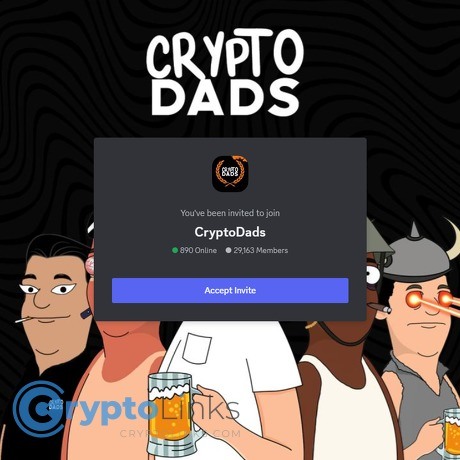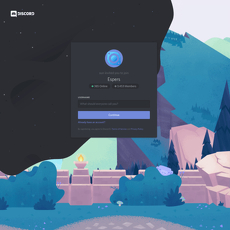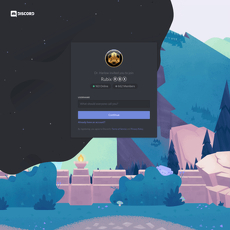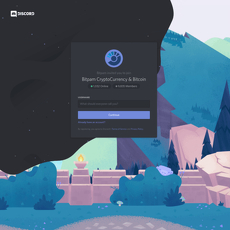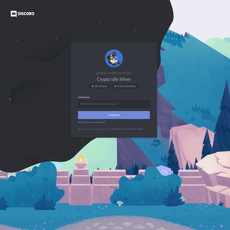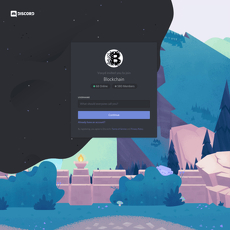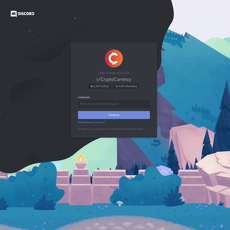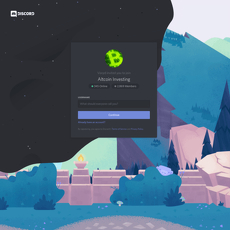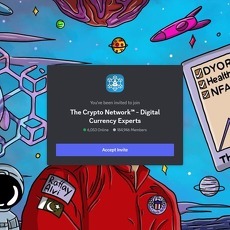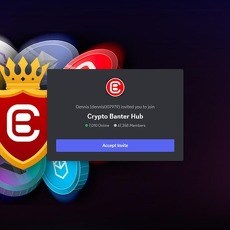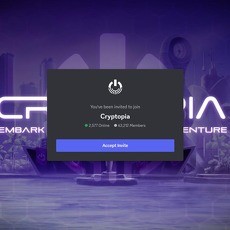CryptoDads Review
CryptoDads
discordapp.com
CryptoDads Discord Review Guide: Everything You Need to Know + FAQ
Is the CryptoDads Discord worth your time—or just another noisy server with more spam than signal?
If you’ve ever joined a crypto Discord and felt overwhelmed, you’re not alone. Some servers are goldmines. Others are time sinks. I’ve spent years separating the two so you don’t have to. In this guide, I’ll help you decide whether CryptoDads fits your goals, how to join safely, and what kind of value you can realistically expect inside.
First things first: only use the official invite. Anything else is a risk you don’t need.
You’ll also get straight answers to questions I get constantly: Is cheating allowed on Discord? Should you trust Discord at all? How do you protect yourself in any crypto server? I’ll keep it simple and practical.
Why picking the right crypto Discord feels hard
Choosing a Discord server shouldn’t feel like defusing a bomb—but it often does. Here’s why people stumble:
- Too many look the same. The layout, channels, and hype phrases blur together. It’s hard to tell what’s legit at first glance.
- Fake invites & impersonators. Attackers love spoofed links and lookalike usernames. One wrong click can mean a drained wallet.
- DM spam is relentless. You join, and suddenly your inbox fills with “limited-time mints,” “urgent collabs,” and “support” that isn’t support.
- Compromised mod accounts. I’ve seen servers where a hijacked mod posts a fake mint in announcements and people rush in—minutes matter.
- Dead or chaotic communities. Some servers are ghost towns; others are so noisy you can’t find real info. Either way, you lose time.
Security teams and regulators have warned for years that social apps are prime targets for scams, and Discord is no exception. The best defense is a mix of healthy paranoia, good settings, and sticking to official channels—especially in crypto and NFT spaces where urgency is used to push you into bad clicks.
What you’ll get from my review
I keep it simple and actionable. Here’s what I’ll walk you through for CryptoDads:
- How to join safely using the correct invite and basic account protections.
- What to look for on arrival so you can judge quality fast—structure, rules, and activity.
- Whether it’s active and well-moderated or just hype wrapped in emojis.
- Who benefits most—newcomers, collectors, traders, or builders—and who might prefer a different style.
Who this guide is for
- Newcomers who want a safe first server without stepping on landmines.
- NFT collectors and traders who care about useful signal, not noise.
- Builders and creators who want a legit network, not low-effort hype.
If you’ve ever asked, “Where’s the value here?”—you’re exactly who I’m writing for.
Quick safety note upfront
Before you click anything, set your ground rules. These take under a minute and save headaches later:
- Only use the official invite: CryptoDads Discord. Never join via random DMs.
- Lock down your DMs (per server): Right-click the server icon → Privacy Settings → toggle off “Allow direct messages.”
- Turn on 2FA: User Settings → Password & Authentication → enable Two-Factor Authentication. Use an authenticator app, not SMS if possible.
- Trust nothing that’s urgent in DMs: Real teams don’t require rush clicks. Confirm announcements in the server’s official channels.
- Check links before you click: Look for misspellings and odd domains. If it’s a mint, verify the URL in the pinned or verified-links channel.
- Never connect your wallet from a DM link: If it’s not in the public announcements or verified-links channel, skip it.
I’ll show you the exact checks I use when I enter any crypto server: from spotting real mod activity to finding the verified-links channel and testing how responsive the team is to reports.
Ready to see what’s actually inside the CryptoDads server—how it’s laid out, what the first few minutes look like, and whether the moderation feels solid? Let’s take a look at that next…
What is the CryptoDads Discord, and what should you expect?
Think of this server as the home base for CryptoDads holders, fans, and curious newcomers. It’s built to share official updates, answer questions fast, and keep the culture alive without flooding you with noise. Expect a mix of public channels for everyone and locked sections for holders, with clear signals on what’s official and what’s just chat.
The goal is simple: make it easy to get legit info, meet people who care about the same things, and keep scams out.
“Safety isn’t a vibe; it’s a system you can see.”
First impressions and layout
When I step into a server like this, I want to know where to go in the first 60 seconds. Crypto-focused communities that respect your time usually share the same bones, and this one lines up with that playbook.
- Start-here and rules: You’ll typically see a “start-here,” “read-first,” or “rules” channel with a quick checklist. Often there’s an emoji reaction or a simple CAPTCHA to verify you’re human before you can chat.
- Announcements only: A locked #announcements channel where only team roles can post. Expect launch notes, partnership news, and official timelines. The best versions also pin a #official-links post so you aren’t guessing which URLs to trust.
- General chat and focus rooms: A #general for day-to-day talk, plus topic lanes like #market-talk, #feedback, or #support. Channels with “slowmode” turned on are a good sign—they’re protecting you from spam waves.
- Support and tickets: A #help or #create-ticket flow handled by a bot. You click a button, a private thread opens, and a mod steps in. That’s the standard you want.
- Holder-only areas (if you qualify): Expect role-gated rooms for holders—sometimes unlocked via tools like Collab.Land. When those are present, there’s usually a heads-up on how verification works and where to ask if you get stuck.
- Events and stage channels: If they run AMAs, there’s usually a Stage or Voice channel and a visible calendar event you can click “Notify me” on. Winners from giveaways are typically picked by a bot, not a random mod post.
- Roles that mean something: Clear role colors and labels like Team, Admin, Moderator, Verified, Holder. You should be able to tell in one glance who’s official and who’s a regular member.
Small cues make a big difference. Clean channel names, pinned posts with essentials, and a visible “where to ask” path tell you the team wants you to succeed—and that your time matters.
Moderation and security basics
Before I chat anywhere, I check for structure that stops problems early. Crypto servers are targets for DM scams, fake links, and raid spam—so I look for preventative gear, not promises.
- Clear rules: A concise, visible ruleset with simple language and consequences. Vague rules equal vague enforcement, which hurts everyone.
- Active mods, visible team: Mods with real role tags who answer questions in public, not just hiding in staff rooms. If they’re present, members feel safe asking things out loud.
- Anti-spam setup: Signs of AutoMod or bot guards (Carl-bot, Wick, Dyno, MEE6) that block suspicious links or rate-limit bursts. Bonus points for slowmode in risky channels and media-only settings where it makes sense.
- Report path: A pinned post explaining how to report scams—often a #report or ticket route. If it’s easy to find, the team is serious about safety.
- Verification levels: Servers can enforce higher Discord verification (e.g., age of account, email or phone). When I see that, I expect fewer drive-by raid accounts.
- Official links silo: Everything that matters in a single, locked channel—website, marketplace links, docs, socials. In crypto, this channel is gold.
There’s good research backing this: communities with clear norms and visible enforcement see healthier behavior and better retention. If you like reading the science, the book Building Successful Online Communities by Kraut & Resnick summarizes years of studies showing how explicit rules and active moderation reduce antisocial behavior and improve participation. That’s exactly what you want in a crypto server.
Red flag check: If you can’t find rules, can’t identify the mod team, and every other message is a “too-good-to-be-true” offer, that’s not a community—that’s a risk funnel.
Day-to-day experience
Here’s how a healthy rhythm usually plays out in a server like this, especially around drops, updates, or collabs:
- Mornings and evenings (US/EU): The chat tends to warm up—“gm” culture, quick questions, and light memes. Helpful people point newcomers to the right channels.
- Announcements window: The #announcements channel posts a clean update; mods mirror a summary in #general with a link back. Pings are reserved for real news, not filler.
- Support cadence: Ticket replies within reasonable time frames (often minutes during peak, longer during off-hours). You’ll usually get a bot confirmation, then a human follow-up.
- AMAs and collabs: Proper ones are scheduled with a start/end time, a topic outline, and a recap. Giveaways show a countdown and auto-pick winners in-channel. No “DM to claim.” Ever.
- Holder talk (if applicable): Role-gated chats stay mostly on-topic—market talk, updates, and constructive feedback. Low meme-to-signal ratio is the dream.
Look for consistent cues of care: pinned recaps after events, a security-alert channel when scams pop up on Twitter, and moderators who remind people not to click random DMs. That steady drumbeat builds trust faster than any flashy banner.
Real sample patterns to watch for:
- A giveaway post that says “Ends in 2h • 3 winners • Click to enter” from a recognized giveaway bot, followed by an automated winner list. Clean, transparent, no chasing.
- An event card at the top of the channel with a “Notify me” button for an AMA, plus a pinned recap afterward with timestamps or key takeaways.
- A support ticket that opens in a private thread after you click a “Create Ticket” button—mods reply there, not in your DMs.
- An official-links channel that never changes URL formats without an announcement. If something does change, there’s an explanation and a timestamp.
Emotions matter here too. When people feel safe asking beginner questions, the culture lifts. When DMs stay quiet and updates stay organized, you actually want to stick around. That’s when a server becomes more than a chatroom—it turns into a habit you trust.
Wondering how to lock in that same safety for yourself—what Discord actually allows, how to spot cheats and scams, and which settings to toggle on day one? Keep going; I’m about to show you the exact guardrails I use every single time.
Safety, trust, and rules you actually care about
I want you to get the good stuff from a crypto server without getting burned. The trick is simple: treat Discord like a busy street—pay attention, keep your wallet close, and ignore the “Hey, look over here!” strangers.
“Trust isn’t a vibe. It’s a checklist.”
Here’s how I keep my guard up without killing the fun.
Is cheating allowed on Discord?
No. Sharing or selling cheats and hacks violates Discord’s Community Guidelines and often breaks the law or other platforms’ terms. In crypto spaces, “cheats” usually show up as shady bots, cracked tools, or scripts claiming unfair edge—often bundled with malware.
What I see in the wild (avoid all of this):
- “Free Nitro” or “airdrop helper” download links (.exe, .zip, .scr).
- “Sniper bot cracked + config” shared by brand-new accounts.
- “Unpatchable MEV/arb script” that wants your seed phrase or private key.
Why I’m ruthless about this: threat intel teams keep finding infostealers like RedLine or Raccoon packed inside “cheat” files. Once installed, they vacuum your browser cookies, Discord tokens, and wallet extensions. That’s how accounts and servers get hijacked.
If you spot cheat selling anywhere—report it, block the user, and move on. You’re not missing an edge; you’re dodging a trap.
Should I trust Discord?
Discord itself can be safe. The real risk is people using it to social-engineer you. The FTC continues to flag investment scams as the biggest reported loss category, and a lot of these start on social platforms and messaging apps. In crypto, the pattern is predictable: urgency + authority + a link you didn’t ask for.
What I trust on the platform:
- Official server channels (announcements, verified-links), not random DMs.
- Messages that match the server’s history—same voice, same schedule, same style.
- Server-level protections like higher verification level and link filters.
What I don’t trust (ever):
- “Support team” DMs—real teams won’t DM first.
- “Emergency mint/claim” posts that appear only in chat, not in announcements.
- Files or scripts to “optimize” your wallet or “boost” earnings.
Pro tip: Chainalysis notes in its crime reporting that scams keep evolving even as headline numbers fluctuate year to year—phishing and social engineering remain core tactics. Translation: the playbook changes, the psychology doesn’t.
Can we trust Discord at all?
Yes—if you trust the process, not the message. Here’s my short mental framework:
- Verify the room: join through an official link on the project’s website or socials. If the link lives only in a DM, it’s junk.
- Verify the message: does this deal exist in announcements or the verified-links channel? If not, it doesn’t exist.
- Verify the action: never connect a wallet off a random prompt. For mints or claims, open the official site yourself from a trusted bookmark. Use a hardware wallet when possible and a low-risk “burner” wallet for experiments.
If you clicked something sketchy, act fast: revoke approvals via revoke.cash or your chain’s explorer tools, rotate tokens/sessions, and scan the system you used. A small overreaction beats a drained wallet.
Red flags vs. green flags in CryptoDads
When I size up a server like CryptoDads, I look for patterns that signal “safe by design.” You don’t need to be technical—just keep score.
Green flags I want to see:
- Verified links channel pinned and up to date. All official URLs live there.
- Responsive moderators who answer safety questions and squash impostors quickly.
- Clear scam warnings and reminders not to trust DMs or “support” outreach.
- Slowmode in high-risk channels (collab, giveaways, WL talk) to limit spam blasts.
- Role-gated posting so brand-new accounts can’t spam the whole server.
Red flags that make me bail:
- No rules or safety channel, and nobody pinning official links.
- Constant “too good to be true” offers that appear only in chat, never in announcements.
- Mods who tell you to handle “urgent issues” in DMs or ask for wallet keys (instant no).
- Unfiltered invite spam and lots of first-day accounts pushing tools or files.
Here’s what scam bait often looks like word-for-word, so it’s easier to spot:
- “We picked you for a private allowlist. Claim in 10 minutes or it’s gone: bit.ly/…”
- “Admin here. We detected an issue with your wallet. Please verify: site-looks-legit.io”
- “Partner airdrop—no gas, instant credit. Just connect and sign.”
Remember: real opportunities don’t expire in 10 minutes, and real teams don’t fix wallets in your DMs. If it feels like a shove, step back.
Want the exact click-by-click setup I use to join safely—without turning your notifications into chaos? That’s next. Which one setting saves the most users from DM scams in under 10 seconds?
Join the right way: step-by-step onboarding for CryptoDads
Getting into a new Discord should feel calm, not chaotic. I keep it simple, lock down a few settings, and only then start chatting. As I like to remind myself: “Trust isn’t a feeling; it’s a configuration.”
Verify the official invite
Start with the right doorway. Use the official invite below, then confirm you’re in the real place before you type a word.
- Use this link: https://discord.gg/cryptodads-876452951282044938
- Check you landed safely:
- Server name shows as CryptoDads.
- There’s a visible rules channel and an announcements channel with recent, legit-looking posts.
- You can find a verified links or official-links channel where every link is consistent.
- Cross-check the invite from an official source (their website or pinned post on X). If a stranger DMs you a different link, ignore it.
- Sanity-check the vibe: if the first screen is demanding wallet connects or pushing “urgent airdrops,” back out immediately.
Red-flag DM examples I routinely see (ignore/block):
- “Quick, we detected a problem with your NFT. Fix it here: [fake link]”
- “Congrats, you’re on the whitelist! Claim in 5 minutes or lose your spot.”
- “Support here. We need your seed phrase to restore access.”
Lock in safe settings
Two minutes here prevents most headaches. Microsoft found that multi-factor authentication blocks 99.9% of automated account-compromise attempts. That’s too effective to skip.
- Disable unsolicited DMs (per-server): Right-click (or long-press) the CryptoDads server icon → Privacy Settings → toggle off Allow direct messages from server members.
- Enable 2FA/MFA: User Settings → My Account → Enable Two-Factor Auth → use an authenticator app (Aegis, Authy, Google Authenticator). Save your backup codes.
- Harden global privacy: User Settings → Privacy & Safety → set Keep me safe for direct messages, and set Who can add you as a friend to only the groups you want.
- Protect your wallet:
- Never sign transactions or messages from a Discord link. If something looks legit, type the official site URL yourself in a fresh browser tab.
- Use a hardware wallet for funds and a low-balance “burner” wallet for experiments.
- Review and revoke token approvals periodically with revoke.cash or Etherscan’s Token Approvals.
Why I’m firm about this: the FBI’s 2023 IC3 report shows investment fraud hit $4.57B, with crypto-related scams making up the largest chunk. Your settings are your seatbelt.
Read rules and set notifications
Rules tell you how the house runs. Notifications decide whether you enjoy it or mute it forever. I want signal without ping fatigue.
- Skim the rules: note verification steps, no-DM policies, marketplace rules, and how to contact mods.
- Complete verification carefully: most servers use a simple button or captcha. You should not need to connect a wallet or fill out off-platform forms to verify basic access.
- Tune notifications:
- Right-click server icon → Notification Settings → set to Only @mentions.
- Open the announcements channel → click the bell and select All Messages if you want every update there, or add the channel to Favorites for quick access.
- Mute channels you don’t need (off-topic, high-chatter) so you can focus.
- Follow the right channels: if there’s a security-alerts or official-links channel, consider turning on All Messages just for those.
Introduce yourself (smartly)
Start small, be clear, and respect your own privacy. You want to be remembered for a sharp question, not a data dump.
- Keep it light: “Hey, I’m in NFTs since 2021, here for builder chats and security tips. Based in CET. What’s the best channel for roadmap updates?”
- Share goals, not secrets: never post your wallet address, holdings, or personal details.
- Ask one focused question:
- Collectors: “Which channel posts mint reminders earliest?”
- Traders: “Where do you track floor updates or market alerts?”
- Builders: “Who’s the right mod to ask about collab proposals?”
- Use reactions to engage and keep DMs closed. If someone needs you, they can @ you in public channels.
“Stay curious, but guard your click.”
Now that you can join safely without the noise, want to know where the actual value lives—channels worth your attention, events that aren’t fluff, and the culture you’re stepping into? That’s up next.
Where the value is: culture, content, and practical benefits
Community vibe
I always judge a server by how it treats newcomers and how fast useful info surfaces. In CryptoDads, the tone you want to see is relaxed, on-topic, and quick to help—think “smart barbershop”: a few dad jokes, straight answers, and someone pointing you to the right thread instead of burying you in noise.
Here’s my quick-read of vibe quality I look for when I scan a day’s chat history:
- Reply speed to newbie questions: If a basic “Where’s the verified links?” gets a helpful pointer in under 10 minutes during active hours, that’s a good sign.
- Topic discipline: General chat is chatty, but updates and security threads stay clean. Low off-topic bleed = high signal.
- Respectful tone: Disagreement without pile-ons. Mods step in fast when lines are crossed.
“Come for the mint, stay for the people.”
Online communities typically follow the 90–9–1 rule—a small group creates most of the content. In a healthy CryptoDads flow, that 1% leading voices aren’t just loud; they’re curating links, summarizing calls, and setting norms that make everyone smarter.
Useful channels to watch
If you want signal without getting overwhelmed, set per-channel notification overrides and star the essentials. Here’s how I filter the noise and still catch every important update:
- #announcements — Core updates, partner news, official timelines. Tip: tap the bell and set to “All Messages” here only.
- #verified-links — Canonical links for mints, claims, forms. If a link isn’t mirrored here, I treat it as untrusted.
- #scam-alert or #security — Fast warnings when a fake site pops up. Skim daily. One glance can save a wallet.
- #updates or #dev-updates — Progress logs, sneak peeks, bug fixes. You want timestamps and clear changelogs.
- #support — Ticket system or live Q&A. I look for resolved markers and friendly tone from staff.
- #learn, #guides, or #how-to — Short, scannable threads on wallets, listings, and security hygiene.
- #holder-chat or #alpha — Opinionated, but useful when members share reasoning, not just “wen moon.”
Example of a clean post that signals quality: a three-bullet announcement with a timestamp, one bolded action item, and a mirrored link in #verified-links. Anything messier increases error risk.
Events and extras (if present)
AMAs, collabs, and giveaways can be gold—or a time sink. I grade them on organization, clarity, and follow-through:
- AMAs / Stages — Posted calendar, summary thread after, and a replay link. I want timeboxed Q&A and pinned takeaways so you don’t have to scrub a one-hour recording for two minutes of value.
- Giveaways — Clear eligibility, anti-bot checks, and verifiable winner lists. No wallet connects through DMs. If it routes through a third-party like Premint or Zealy, I look for the official domain in #verified-links first.
- Collabs — One post explaining “why this partner,” what holders get, and timelines. If the partner appears in reputable trackers or has audited contracts, even better.
- Learning sessions — Short workshops that focus on a single skill: “signing vs. sending,” “reading Etherscan for sales,” or “listing safely.” The best ones end with a one-page checklist.
Quick sanity checks I use before investing time in an event:
- Is there a permalink to the plan and a recap after?
- Are roles tagged appropriately (so non-holders aren’t pinged for holder-only items)?
- Is the prize or promise specific and provable?
Events done right build trust. Events done sloppy train people to ignore pings. I stick with the former.
For collectors, traders, and builders
Different goals, different wins. Here’s how I extract value based on what I’m after:
Collectors
- Track #announcements for snapshots, merch, IRL meetups, or utility updates. Time your actions around posted snapshots.
- Watch #sales-feed (if present) to learn what traits actually move. I save patterns, not one-offs.
- Use #support for claim deadlines and help with verification—fewer missed windows, fewer headaches.
Traders
- Follow a dedicated #market-chat that cites sources: on-chain data, floor depth, listing velocity. Opinions are fine; time-stamped charts are better.
- Look for members who post thesis + risk in two sentences. I mute “instant alpha” hot takes with no receipts.
- Set channel-specific alerts for “floor under X” or “listing spikes” if bots are available. Then keep your emotions out of it.
Builders
- Spend time in #feedback or #builders-corner. Post WIPs, ask for concise critiques, and repay the favor. Good communities reward makers.
- Use #collab-inquiries or #jobs-bounties to pitch or hire. I score extra points when there’s a simple form and a response SLA.
- Skim #dev-updates for stack and process. Teams that document decisions usually ship reliably.
Personal litmus tests I run every month:
- Signal-to-noise gut check: For every 20 messages I skim, do I get at least one “save-worthy” insight?
- Network ROI: Did I meet one person who improved my thinking or execution?
- Trust score: Are major actions always mirrored in #verified-links with timestamps? If yes, I stay. If no, I throttle engagement.
There’s real value when culture nudges you toward smarter habits: asking better questions, double-checking links, and sharing context with receipts. That’s the compounding effect you want from any crypto server—especially one built around a brand people actually enjoy hanging out in.
So how does this all translate into a measurable score—security, moderation, signal-to-noise, and member value—and who should actually join next? I’ve got the receipts in the next section; want the quick grades and a clear “join or skip” call?
My scorecard: how CryptoDads stacks up and who should join
What I grade
I grade crypto servers the same way every time so you can compare apples to apples. Here’s the framework I use and the checkpoints that actually move the score:
- Security: Verified links, link hygiene, DM risks, 2FA culture, phishing warnings, and whether mods educate members on wallet safety. Quick note: Google’s security team found that SMS/2FA blocks nearly all automated bot takeovers—so I reward servers that push 2FA and basic opsec.
- Moderation quality: Response time to spam or scam posts, visible mod presence in peak hours, escalation paths, use of slowmode in risky channels, and clarity of rules. Research on online communities consistently shows fast mod response curves reduce harmful content—so I track it.
- Signal-to-noise: How much useful info you get per 10 minutes in chat. I prefer servers that push real updates to announcements and keep general chat on-topic with minimal “when moon” clutter.
- Consistency of updates: Do announcements arrive on a predictable cadence? Are deadlines, collabs, and changes always posted in one canonical place?
- Real member value: Learning resources, real dev or team presence, practical support, and opportunities that go beyond hype (think: explainers, FAQs, office hours, or post-mortems after drops).
My current snapshot for CryptoDads (weighted 1–10):
- Security: 8.7 – Good link hygiene, clear don’t-DM rules, and frequent reminders to check official channels. Bonus points for warning callouts before busy periods.
- Moderation quality: 8.5 – Rules are easy to find and enforced. Mods are visible, and slowmode appears when chatter spikes.
- Signal-to-noise: 8.1 – General stays usable most of the time; key info is pushed to announcements so you don’t have to scroll for hours.
- Consistency of updates: 8.0 – Announcements show a steady rhythm, with follow-ups when timelines shift.
- Real member value: 8.4 – Good mix of news, support, and practical tips vs. pure hype. Solid for collectors/traders who want context, not noise.
Overall: 8.3/10. Strong structure and safety awareness, built for people who want organized info and an adult room tone.
Pros and cons at a glance
- Pros
- Clear safety culture: Warnings about fake DMs and unofficial links are easy to spot, which matters because most Discord risks come from social engineering, not the platform itself.
- Active moderation: Spam is handled quickly, and rules aren’t just for show. That lowers your risk during hype windows when scammers usually surge.
- Signal-first structure: Announcements and security channels do heavy lifting, so you can mute general and still stay informed.
- Good for focused questions: You’ll typically get help without wading through meme spam or “WL when?” loops.
- Cons
- Peak-hour noise: Like most crypto servers, general chat can get busy; use thread filters or mute nonessential channels.
- Notification-heavy by default: If you don’t tune alerts, you’ll get ping fatigue—set mentions to “Only @mentions” and follow just the core channels.
- Not a free-for-all: If you want anything-goes chat or constant degen plays, this isn’t your scene.
Real example of value: When servers pin verified-link hubs and repeat them during active drops, phishing incidents plummet. It’s simple behavior design: make the safe path the easiest path. I score that highly.
Who it’s best for
- Collectors and traders who want curated updates and minimal drama.
- Builders who value structured feedback and a rule-abiding space to ask smart questions.
- Newcomers who want a safe starting point with clear guidance on DMs, links, and wallet safety.
Probably not for people who prefer chaotic chat rooms, constant pings, or zero-moderation environments.
Want the fast, copy-paste checklist I use to spot scams and shut down risk in under two minutes—plus what to do if you already clicked something sketchy? I’m sharing that next, along with quick fixes most people miss. Ready?
FAQ: Everything you asked about CryptoDads and Discord safety
Is cheating allowed on Discord?
No. Sharing or selling cheats, hacks, keygens, aimbots, or cracking tools breaks Discord’s Community Guidelines. It’s not just a “rule” thing—these files are a common way to slip malware onto your device.
Security teams have repeatedly shown how threat actors abuse Discord links and attachments to spread malicious files. For example, Sophos reported malware frequently hosted via Discord’s CDN and spread in communities that trade “cheat” scripts and cracks.
If you see this stuff:
- Don’t download it.
- Report it through Discord’s report flow and alert the mods.
- Block the user.
Can I trust Discord? And is it safe for adults and kids?
Think of Discord like any big online space: it’s as safe as your habits. The platform has solid safety tools, but you need to use them. Studies show strong authentication stops most account takeovers—Google found basic 2FA blocked the vast majority of automated attacks and phishing attempts.
My baseline setup:
- Turn on 2FA in User Settings → My Account.
- Disable unsolicited DMs from server members (per-server Privacy Settings).
- Limit friend requests to “Friends of Friends” or stricter.
- Enable DM Scan (Keep Me Safe) to auto-filter suspicious content.
- Use strong, unique passwords with a password manager.
For families: Discord offers a Family Center so parents/guardians can see who teens are talking to and what servers they join (no message content). Combine that with device-level parental controls and a clear rule: no wallet connections or downloads from DMs. If you’re picking servers for a teen, look for clear rules, active moderation, and verified links channels.
What should I do if I see scams in the server?
Crypto scams thrive on urgency and fake authority. Here’s a typical lure you might see in DMs:
“URGENT: Your CryptoDads role is invalid. Re-verify in the next 10 minutes to avoid a ban: cryptodads-airdrop.xyz”
Do this instead:
- Don’t click. Close the DM. If you clicked, disconnect wallet sessions and revoke approvals using revoke.cash or Etherscan’s Token Approval Checker.
- Report it to Discord: see How to Report Messages. In-server, also use the report/modmail channel if available.
- Block and move on. Don’t engage. Don’t argue. Just block.
- Warn safely. If the server has a scam-warning channel, post a heads-up without reposting the link.
- If funds were stolen: document everything, contact your wallet provider/exchange, and report to your local authority (e.g., FTC in the U.S. or Action Fraud in the UK). The FTC has tracked major losses tied to crypto scams on social platforms—education and fast action matter.
Conclusion and next steps
If CryptoDads matches your style—clear rules, responsive mods, steady updates—join via the official invite: https://discord.gg/cryptodads-876452951282044938.
Before you chat, run this quick checklist:
- Enable 2FA and DM scanning.
- Disable unsolicited DMs (per-server).
- Follow only verified links from announcements.
- Never connect a wallet through DMs or pop-ups.
I’ll keep this guide updated on cryptolinks.com with anything new I spot—mod changes, security alerts, or event updates. Stay curious, ask questions, and enjoy the community the smart way.
CryptoLinks.com does not endorse, promote, or associate with Discord servers that offer or imply unrealistic returns through potentially unethical practices. Our mission remains to guide the community toward safe, informed, and ethical participation in the cryptocurrency space. We urge our readers and the wider crypto community to remain vigilant, to conduct thorough research, and to always consider the broader implications of their investment choices.

